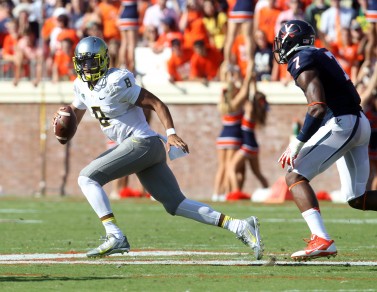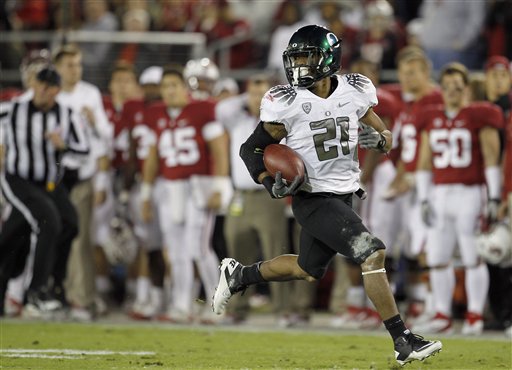A couple of years ago, as Andrew Luck suffered another 20-plus point defeat to the Oregon Ducks at Stanford Stadium, a familiar statement was circulating around that “Stanford has an Oregon problem.”
Of course, this refers to the fact that Stanford, but for a loss to Oregon in two consecutive years, would have been in the BCS National Championship Game. They were not fluke losses either; the Ducks simply outflanked the Cardinal and ran past them. Many theorized that Stanford’s beef simply could not stand up to the fast pace and speedy tempo set by the Ducks. Speculation abounded that maybe the Cardinal were spending their off-season workouts preparing for this one fast paced game.
In reality, the reasons for Stanford’s losses were many and complex. Size was not their hindrance — nor speed. Oregon had simply made plays against the Cardinal with very few mistakes. If you play mistake free against Stanford and jump to larger than a 10-point lead, the game plan of the Cardinal is fundamentally changed, as the offense can no longer play ground and pound.
Last season, after the dust settled in Stanford Stadium, local and national pundits alike began to ask the question, “Does Oregon now have a Stanford problem?” Everyone with an opinion expressed the belief that Oregon needed to change some philosophies to catch back up to Stanford. The problem with this line of reasoning is that Stanford was not doing anything different, they were just doing it better. At the same time, Oregon was making mistakes they had not made in the prior match-ups and with a hobbled former Heisman candidate came both dropped and overthrown passes. These had more to do with the Ducks loss a season ago down on The Farm. Nonetheless, the national perspective had changed. The way to beat Oregon? Be bigger and stronger.
Nine days later, it appeared as if Stanford had once again, developed an Oregon problem. By focusing all of their energies on finding the formula for defeating a single team, a fundamental flaw of the Stanford formula that had already been exposed by Utah, was now being exacerbated by USC.
To be fair, USC was completely renewed against Stanford with the energy provided by interim coach Ed Orgeron. That loss, while not completely acceptable for a team billed as an elite squad, was at least understandable. The Utah loss? There was just no excuse. Despite being on the road, Stanford should have been considerably better than the Utes. The Cardinal had escaped with a win a week earlier after being outplayed for much of the game against the Washington Huskies.
Stanford struggled again a week later to put away Oregon State. This team had many defects, yet somehow managed to completely dismantle the high flying Ducks for three-plus quarters, before a furious comeback by the Ducks came up just a little short.
The only way Stanford can beat Oregon is to play the perfect game and hope that Oregon makes mistakes which will cause them to lose. When Stanford does not play perfect, as they have not most of the 2013 season, they struggle to put away teams that they should easily beat. That’s what happened both in Utah and against the Trojans in the Coliseum a season ago.
Stanford made their hay, so to speak, with a solid running game and ‘elephant’ packages that included two and three tight ends. Suddenly, with the departure over the prior two seasons of tight ends Coby Fleener, Zach Ertz and Levine Toilolo, the Cardinal have left themselves turning to offensive linemen in those elephant packages.
Unlike Oregon a week prior, the USC Trojans adjusted to those elephant packages and forced Stanford to beat them through the air; Kevin Hogan, without the safety-valve tight ends to use, struggled in his decision making and forced plays he did not force against Oregon.
Where Hogan and the Cardinal did everything right nine days earlier, they failed miserably with against the Trojans.
The interesting difference? After Oregon struggled down the stretch against both Arizona and Oregon State and failing to contain the running game against them, critics were out in force questioning head coach Mark Helfrich’s ability to lead this Duck team to more victories. Had he gotten in over his head? Strangely, though, there were no such critics voicing a “fire David Shaw” opinion. Even when it looked for a brief moment as if their shot at the Rose Bowl had vanished, the critics were minimal. He had beaten Oregon and that seemed to be all that mattered.
The Cardinal put all their eggs in the “Beat Oregon” basket and it cost them two separate games last season. It almost derailed their shot at the Rose Bowl and likely cost them a shot at a possible BCS National Championship Game berth.
Oregon may have lost the game on the field at Stanford Stadium a year ago, but so did Stanford.
Top photo by Kevin Cline
Related Articles:
Chip Kelly Update: Everything's Good Again ...
Chip Kelly Update: Wailing and Gnashing of Teeth
Shock and Awe -- The Oregon Ducks' Football Hangover Effect
Despite Lopsided Score, Georgia State "Never Stopped Believing"
Hope Springs Eternal for Ducks
Incompetent Pac-12 Officials: How Do You Miss ALL of THIS?
Scott Reed has been a fan of the Ducks from his first days listening to Wendy Ray in 1974 on a scratchy AM radio from Oakridge; forty long years of fandom. He has been a long time contributor to Duck Sports Authority and stumbled into formal writing about the Duck program in 2011 when he looked at the “other side” of the Will Lyles investigation. Long known as “Ducks39” on message boards, he branched deeper into writing for Duck Sports Authority covering games and recruiting for the last four seasons.
Scott works for Roush Industries in Portland as the Operations Supervisor. He received a Bachelor of Science in Management from the University of Oregon in 1994 with honors. Scott is also a long time power lifter who spent time as an Assistant Strength Coach at the University of South Dakota.
He and his wife live in Beaverton. Scott has two grown sons and two step-sons. In what spare time he has left, he likes to read philosophy and lift weights.



